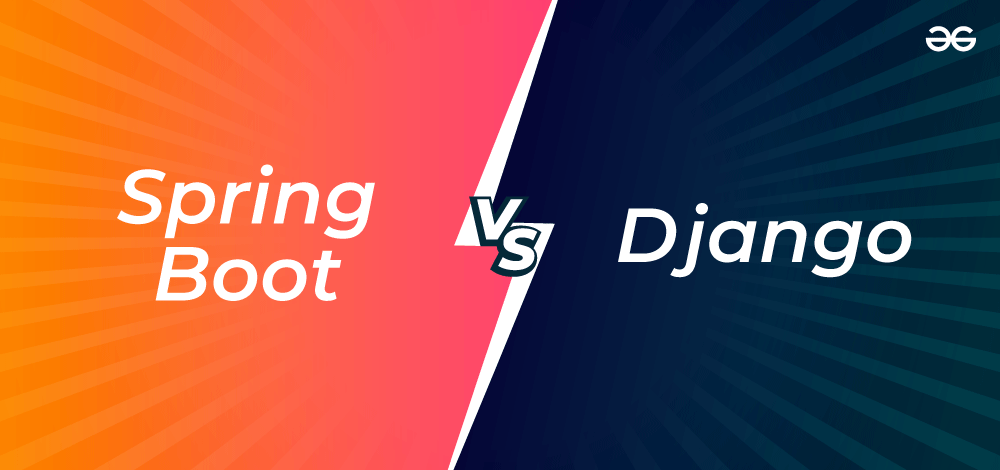In the fast-paced world of web development, picking the right framework is like choosing the base for a tall building. It’s super important! Imagine you’re picking the perfect foundation for a skyscraper. Now, there are two big contenders in this web development game: Django and Spring Boot. They’re like your trusty sidekicks, each with their own cool tools and ways of doing things. Picture it as if you’re choosing between two superhero friends.
As we explore the distinctive features of these frameworks, get ready for an enlightening adventure. Highlighting their unique qualities and analyzing their operation is our main objective. Think of it as a thorough exploration of Django’s and Spring Boot’s internal operations, explaining to you why they are unique in the online development community. Excitement about this investigation? Let’s dive in and learn together!
What is Django?
Django is a high-level web framework for making websites with Python. It generally equips developers with a set of tools, design patterns, and agreed-upon ways of doing things which makes it easier to create robust and scalable websites. Django follows the model-view-controller (MVC) architectural pattern, where the model represents the data structure, the view handles the user interface, and the controller manages the flow between the model and the view.
What is Spring Boot?
Spring Boot is also a web framework based on Java. It is an open-source framework that simplifies the development of stand-alone, production-level Spring-based applications. Its purpose is to make the process of developing Java Spring applications as easy as possible. Spring Boot mainly uses the Spring framework as its base and follows a principle of: “convention over configuration.” This means that it gives you sensible defaults, making things easy and cutting down on the need for lots of complicated setups and repetitive code.
Now let’s move up to Django vs Spring Boot.
Django vs Spring Boot
Django and Spring Boot are two popular frameworks for web development, based on Python and Java respectively. They both have many advantages like scalability, security, fast development, and a robust library and package environment. But they also , differ in a few other areas as well, including performance, usability, learning curve, and applicability for various project sizes and complexity levels. Here is a brief comparison of Django vs Spring Boot
1. Language and Ecosystem
- Django: Built on Python, Django leverages the language’s simplicity and readability. Python’s extensive library support and vibrant community contribute to the framework’s ecosystem, facilitating integration with various tools and technologies.
- Spring Boot: Spring Boot utilizes Java, a versatile and widely adopted programming language. Java’s strong typing and performance make it suitable for enterprise-level applications. The Spring ecosystem provides comprehensive solutions for various aspects of development.
2. Architecture
- Django’s MVT Architecture:Django follows a unique architectural pattern known as the Model-View-Template (MVT), a slight variation of the more commonly known Model-View-Controller (MVC) pattern. It underscores the importance of clean separation of concerns and modularity in application design.
- Model (Data Layer):
- Represents the data structure and handles the database interactions.
- Utilizes Django’s Object-Relational Mapping (ORM) for seamless database communication.
- Encourages a clean separation of data-related concerns from the rest of the application.
- View (User Interface):
- Manages the presentation layer and user interface components.
- Processes user input and interacts with the model accordingly.
- Renders the appropriate template to display information to users.
- Template (Presentation Layer):
- Deals with how data is presented and displayed.
- Django’s templating engine allows developers to create dynamic HTML by embedding Python-like code.
- Enables the easy integration of data from the model into the final user interface.
- Model (Data Layer):
- Spring Boot’s MVC Architecture:Spring Boot adheres to the Model-View-Controller (MVC) architectural pattern, a widely adopted approach in web development. This versatility positions Spring Boot as an ideal choice for scalable and distributed systems.
- Model (Data Layer):
- Represents the data structure and manages the application’s business logic.
- Utilizes the Spring Data project for streamlined database access.
- Maintains the state of the application and communicates with the database.
- View (User Interface):
- Handles the presentation layer and user interface components.
- Renders data received from the model for user interaction.
- Remains agnostic about the underlying business logic.
- Controller (Application Logic):
- Manages the flow of data between the model and view.
- Processes user input and updates the model accordingly.
- Orchestrates the interaction between the user interface and the underlying data model.
- Model (Data Layer):
In addition to the traditional MVC pattern, Spring Boot excels in supporting Microservices architecture, offering a more modular and distributed approach.
3. Database Support
- Django
- Django’s standout feature lies in its robust Object-Relational Mapping (ORM) system.
- This ORM system enables developers to interact with databases using Python objects, abstracting away the intricacies of SQL queries.
- The result is code that is not only more readable but also highly Pythonic, simplifying the development process.
- Django’s commitment to versatility extends to its database support.
- Developers can seamlessly integrate with a range of databases, including PostgreSQL, MySQL, SQLite, and Oracle, providing flexibility based on project requirements.
- Spring Boot
- Spring Boot’s database support is intricately connected with the Spring Data project.
- Spring Data provides a consistent and easy-to-use approach to database access, simplifying data management tasks.
- The integration with Spring Data allows developers to interact with various databases effortlessly.
- Much like Django, Spring Boot exhibits a broad compatibility spectrum when it comes to databases.
- Whether dealing with traditional relational databases like MySQL and PostgreSQL or venturing into the NoSQL realm with MongoDB, Spring Boot adapts seamlessly.
4. Community and Documentation
- Django: The Django community is vibrant and active, fostering collaboration and support. The documentation is not only comprehensive but also accessible to beginners, easing the learning curve and ensuring a wealth of resources for problem-solving.
- Spring Boot: Benefiting from the extensive Spring community, Spring Boot enjoys a wealth of online resources and a robust support system. Its documentation is very comprehensive that supports a wide range of use cases and scenarios, which additionally increases its reputation as a trustworthy framework.
5. Flexibility and Customization
- Django
- Django follows a “batteries-included” philosophy, which means that it comes with a lot of built-in features and tools. This includes an ORM (Object-Relational Mapping) system which is a technique that creates a layer between the language and the database, an admin interface, authentication mechanisms, and more.
- This philosophy accelerates development because developers don’t have to start from scratch or search for third-party packages for common functionalities.
- Django also provides a wide range of built-in features and module which includes authentication, URL routing, form handling, and an admin interface. These are generally designed to work seamlessly together by reducing the need for various external dependencies.
- Due to which Developers can focus more on building specific application logic rather than spending time their in integrating various components. This method works really well for projects that only need a standard set of features.
- Spring Boot
- Spring Boot, part of the larger Spring Framework, is known for its modular architecture. It allows developers to choose and include only the components they need for a particular project. This modularity of th spring boot enhances customization possibilities.
- Generally Developers have the flexibility to choose specific components according to their project’s needs, creating a lighter application. This becomes very helpful in microservices environments where different services may required different functionality.
- With different capabilities like data access, security, and messaging, Spring Boot offers a wide range of sections and pieces. Developers can choose the components that fit their project, mixing and matching as needed.
- This flexibility is became very beneficial for projects that generally need diverse requirements. In Spring Boot, developers can choose from the components that best fit their requirements, which helps them in creating more personalized and efficient application.
6. Learning Curve
- Django: Django’s simplicity and clean design contribute to a relatively gentle learning curve, especially for developers familiar with Python. Adding the “Django Admin” tool makes administrative work more easier and simpler.
- Spring Boot: By having its association with the broader Spring ecosystem, Spring Boot exhibits a steeper learning curve. However, it is accessible, especially for developers with prior Java experience, because to its comprehensive documentation and wealth of online resources.
7. Testing Support
- Django
- Unit, integration, and asynchronous code testing are all essentially supported by the extensive testing infrastructure that Django offers.
- It has a strong support for testing individual components in isolation which generally called unit testing.
- The framework makes integration testing very easy by allowing developers to evaluate how various components work together and make sure the programme runs smoothly as a whole.
- One of the most important features for applications that consist the asynchronous programming pattern is that Django’s testing tools allows developers or testers to test asynchronous code.
- Spring Boot
- Spring Boot seamlessly integrates with the JUnit testing framework, a widely used testing library present in the Java ecosystem.
- Spring Boot gives developers various set of tools so they can perform unit testing, integration testing, and end-to-end testing.
- The testing tools provided by Spring Boot help write well-tested code, which improves the maintainability of the programme in the end.
- Spring Boot facilitates easy mocking and dependency injection during testing, allowing developers to isolate components and test them in isolation.
8. Security Features
- Django
- Built-in security mechanisms in Django protect the programme from common online vulnerabilities.
- Django generally encourages the secure coding practices that reduces the risk of security breaches and attacks.
- Django supports Cross-Site Scripting (XSS) protection, mitigating risks associated with malicious script injections.
- Cross-Site Request Forgery (CSRF) protection is enforced by Django to prevent unauthorized actions through forged requests.
- Spring Boot
- Spring Boot integrates with robust security mechanisms, covering various security aspects such as authentication, authorization, and protection against common security threats and vulnerabilities.
- The flexible security setup of the spring boot lets developers to customize the security based on what their project needs.
- It also has an authorization function that allows developers to set and control the permissions and access levels for their Spring Boot application.
- Spring Boot provides flexibility without compromising on security in which developers can create their security configurations to meet the specific requirement for their application.providing flexibility without compromising on security
Django vs Spring Boot
| Parameters | Django | Spring Boot |
|---|---|---|
| Language | Python | Java |
| Ecosystem | Rich libraries, active community | Comprehensive Spring ecosystem |
| Architecture | Model-View-Template (MVT) | Model-View-Controller (MVC), Microservices |
| Database Support | ORM system, multiple databases | Spring Data, wide database compatibility |
| Community & Documentation | Vibrant community, beginner-friendly docs | Extensive Spring community, detailed docs |
| Flexibility & Customization | Batteries-included, less customizable | Modular, customizable, lightweight approach |
| Learning Curve | Relatively gentle, Django Admin for simplicity | Steeper, but comprehensive documentation |
| Testing Support | Robust testing framework | Integration with JUnit, comprehensive testing |
| Security Features | Built-in security features | Robust security mechanisms, modular approach |
Conclusion
At last, whether you find Django more appealing for its simplicity or you like Spring Boot for its versatility, each framework comes with its own set of unique strengths. Django offers a quick start with a gentle learning curve, while Spring Boot provides scalability and customization. The choice depends on totally your project’s requirements, your team’s expertise in case you are working on group project, and the flavor of superhero you need for your coding adventure.





